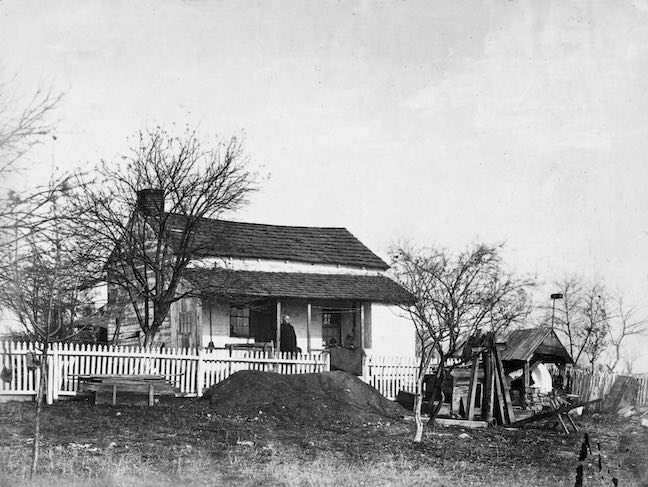| Credit: | by OSullivan (Timothy H.) |
|---|---|
| Date: | 1863.07 |
| Negative Size: | 8 in. x 10 in. |
| Locations & Lines: | Cemetery Ridge PA; Gettysburg PA; Gettysburg battlefield PA; Pennsylvania |
| Military Units: | Army of the Potomac; US Army |
| Persons: | Meade (George G.) |
| Structures & Establishments: | Gen. Meades headquarters (Gettysburg PA) |
| Sources: | Library of Congress; National Archives; University of Maryland (Baltimore County) |
$4.99
File Details: AIKXm, 400 DPI, TIFF, Original Photograph, 9.2 Mb
Image ID: AIKX
Gardners Photographic Sketch Book Of The War. Vol. 1, No. 43. Head-Quarters Major General George G. Meade, during the battle of Gettysburg. July, 1863. Headquarters Army of the Potomac during the Battle of Gettysburg. Just back of the cemetery at Gettysburg, on the road leading to Taneytown, stands a humble dwelling, made historical by its occupation as headquarters of General Meade. This officer having assumed command of the Army of the Potomac at Frederick, thirty miles distant, immediately sent out the several Corps on different roads toward Harrisburg, with orders to attack the enemy wherever he might be found. On the first of July, Reynolds, with the First Corps, engaged the Confederates at Gettysburg, and after a gallant struggle, in which that officer was killed, the Corps, reinforced by the Eleventh, retired to the strong position on Cemetery Ridge. General Meade first heard of the engagement and its result at Taneytown, then miles away, about sundown. Orders were at once despatched [sic] for the other Corps to march for the scene of action. The headquarters camp was struck, tents and wagons were sent back to Westminster, and shortly after midnight the General and staff pushed on to Gettysburg, establishing headquarters at this house. The second of July was one of the most lovely days of the season, and, with the exception of occasional shots between the advanced picket lines, remained perfectly quiet until three oclock. The headquarters, however, throughout the day presented a most animated appearance. Commanding officers and couriers were constantly arriving and departing, while the staff officers and escort lounged in the shade about the house, or slept on the green turf, gathering strength for the conflict momentarily expected to commence. In the afternoon, Sickles, with the Third Corps, was attacked by the enemy, and the battle finally became general, the First, Fifth, Sixth and Eleventh participating, with the Second and Twelfth in reserve in the rear of the right wing. The headquarters, from its exposed position, at once became the centre of a terrible artillery fire. Shot and shell plunged through the building in quick succession, and made sad havoc with the group about it. In a few minutes a number were killed, and the General was soon compelled to withdraw, leaving dead and struggling horses on every side. On the third day the house was exposed to even a more severe fire, which threatened to utterly annihilate it. Immediately after the battle, the owner returned, repaired the damages, and the building now promises to stand for many years, bearing the scars of hat [sic] fierce conflict.

